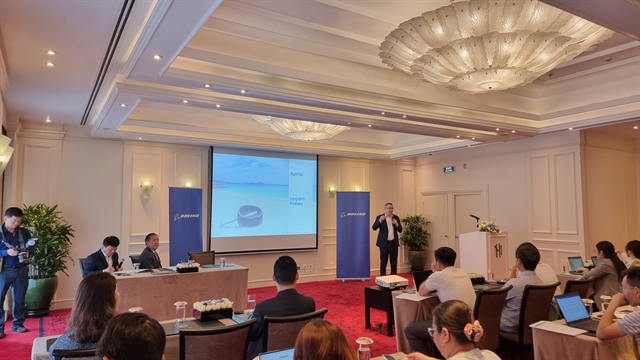According to Boeing’s latest Commercial Market Outlook (CMO), Southeast Asia is the fastest-growing aviation region in the world and Việt Nam is leading the way with an annual growth rate of more than eight per cent—higher than any other country in the region.

HÀ NỘI — Việt Nam is fast becoming a major force in the global aviation landscape, with its commercial aviation sector projected to double in terms of passenger volumes within the next decade, reaching over 75 million travellers annually.
According to Boeing’s latest Commercial Market Outlook (CMO), Southeast Asia is the fastest-growing aviation region in the world, and Việt Nam is leading the way with an annual growth rate of more than 8 per cent – higher than any other country in the region.
At a media briefing held on April 24, Boeing’s Marketing Director, Dave Schulte, highlighted Việt Nam’s increasing significance in Boeing’s regional strategy.
Schulte said: “This year marks the 30th anniversary of Boeing’s partnership with Việt Nam, dating back to when Vietnam Airlines leased three Boeing 767-300ER aircraft in 1995.
“We cannot disclose the delivery timeline of the Boeing 737 MAX orders, as they depend on Vietjet and Vietnam Airlines. However, these deals already show that Việt Nam is one of Boeing’s most promising markets today. We expect to receive many more orders from Vietnamese airlines in the future," he added.
Boeing’s data suggests that airlines across Southeast Asia will need approximately 4,720 new aircraft over the next 20 years, 80 per cent of which will be single-aisle models like the 737 MAX. Vietjet has already placed an order for 200 Boeing 737 MAX jets, while Vietnam Airlines has committed to purchasing 50. These orders are part of broader strategies by Vietnamese carriers to expand routes across Asia and capitalise on booming domestic demand.
Schulte emphasised that the 737 MAX is well suited to Việt Nam’s rapidly growing network of domestic and regional routes, particularly to cities like Cần Thơ, Huế, Hải Phòng, Đà Lạt, Phú Quốc and Nha Trang.
He said: “With its stable and efficient performance, the 737 MAX offers airlines operational flexibility and significantly boosts route profitability. More importantly, it reduces fuel consumption and carbon emissions by up to 20 per cent compared to previous-generation aircraft.”
Việt Nam’s aviation infrastructure is also evolving to meet rising demand. The opening of Terminal 3 at Tân Sơn Nhất International Airport and the anticipated launch of Long Thành International Airport by 2026 will unlock new opportunities for growth.
Boeing’s forecast aligns with Việt Nam’s broader economic trajectory. The country's GDP is projected to reach over US$670 billion by 2029, advancing from the world’s 37th to 29th largest economy. This economic ascent is expected to fuel demand not only for passenger aircraft but also for freighters. Southeast Asia is projected to require over 120 new or converted cargo aircraft by 2043, with Việt Nam playing a critical role in regional air cargo logistics.
As demand for air travel and freight grows, so does the need for skilled labour. Schulte estimated that: “Over the next 20 years, the aviation industry across Southeast Asia – including Việt Nam – will need to recruit and train around 234,000 new personnel, including pilots, engineers and ground staff.”
This surge in demand will triple the current aviation workforce in the region and unlock significant employment opportunities. — VNS





